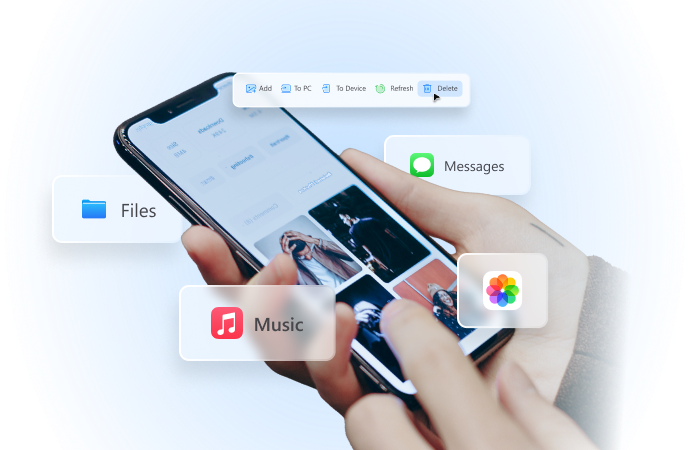
8 Ways to Transfer Music to an iPhone Without iTunes
Oct 24, 2025 • Filed to: Device Data Management • Proven solutions
Dr.Fone Basic:
Better Control for Your Phone
Manage, transfer, back up, restore, and mirror your device
Are you looking for a way to copy songs to your iPhone without iTunes? We are here to help!
iTunes gives you seamless access to your songs across devices. However, it only syncs your music files and replaces the existing songs with the newly synced items. This can be frustrating! You end up losing access to your most-liked tracks.
But don’t worry! There are ways to transfer music to an iPhone without iTunes. This guide will tell you all about it. We will share manual methods and a quick, automatic iPhone transfer solution. So you can listen to your favorite tracks on your iOS device!
Ready? Let’s go!.
- Part 1. Can You Add Music to the iPhone Without iTunes?
- Part 2. How to Transfer Music to iPhone Without iTunes [5 Manual Ways]
- Way 1. Transfer Using DropBox
- Way 2. Send with Google Drive
- Way 3. Transfer Through iCloud Drive
- Way 4. Send via Email
- Way 5. Transfer Using AirDrop
- Part 3. How to Put Music on iPhone from Computer Without iTunes [In Just Clicks]

- Part 4. How to Download Music on iPhone Without iTunes via Streaming Apps
Part 1. Can You Add Music to the iPhone Without iTunes?
A simple answer is yes! A dedicated iPhone data transfer tool is reliable for transferring music to an iPhone without iTunes. These tools can quickly send extensive music data to your iPhone.
Some manual options include:
- Cloud Storage Platforms: These can be iCloud Drive or third-party platforms like Dr.Fone or Google Drive.
- Using an Email: You can send your files to yourself using an email. However, this can only transfer a small number of files.
- Direct Download: You can directly add music to your iPhone without iTunes. This is possible with streaming apps like Apple Music or YouTube Music.
Let’s move ahead and get into the details of these methods.
Part 2. How to Transfer Music to iPhone Without iTunes [5 Manual Ways]
This section will provide stepwise instructions for transferring music to an iOS device. These methods let you send and sync songs between devices without relying on iTunes.
Let’s explore these together!
Way 1. Transfer Using DropBox
Are you looking to sync your music files between your iPhone and computer? Dropbox offers an easy solution. It’s ideal for accessing your songs across multiple devices.
However, you need an internet connection to upload the files. Storage space is another concern. It only offers 2GB of free storage. This can be inconvenient for large transfers.
Here’s how to add music to your iPhone without iTunes.
Step 1. Download and install Dropbox on both devices. Sign in with the same ID.
Step 2. Open Dropbox on your computer. Click the “Upload or Drop” button.

Step 3. Choose the music files to upload and wait for the upload to complete.
Step 4. Open Dropbox on your iPhone. Select the “Files” option at the bottom.
Step 5. Find your uploaded songs. Tap the three dots next to the file. Then, choose “Make Available Offline.”

Step 6. Wait for the file to download. It is in the “Offline” section of the app.
Way 2. Send with Google Drive
Google Drive can help you upload music to an iPhone without iTunes. It provides 15 GB of free storage. You can use it for large file transfers.
Here’s how it helps you copy music from a pc to an iPhone without iTunes.
Step 1. Go to Google Drive in your browser. Sign in with your Google account.
Step 2. Click the “New” button. Then, choose “File Upload” and select your music files.

Step 3. Install Google Drive on your iPhone.
Step 4. Open the app and go to the uploaded music folder.
Step 5. Find your desired music file. Then tap the three dots next to it.
Step 6. Select “Make Available Offline” to stream offline through Google Drive. Otherwise, tap “Open > Save to Files > Save.”

Way 3. Transfer Through iCloud Drive
Another solution to copy music to iPhone without iTunes is using iCloud Drive. You can access it on both Windows and Mac. Plus, it offers 5 GB of free storage to transfer files.
Here’s how to put music on iPhone without iTunes using it.
Step 1. Go to iCloud.com. Log in with your Apple ID. Select the iCloud Drive option.

Step 2. Click the Upload button. It is a cloud with an arrow. Then, select the music files to upload.

Step 3. Open Settings on your iPhone. Tap on your Apple ID at the top.
Step 4. Select iCloud. Toggle on the iCloud Drive.

Step 5. Open the Files app on your iPhone. Go to the “iCloud Drive.” Find your uploaded music files and download them.
Way 4. Send via Email
Do you want to transfer a few songs quickly to your iPhone? You can transfer them using an email. It could be any email platform like Gmail or Yahoo. However, sending files may take time. Moreover, the file size limits can restrict large music libraries.
Let’s see how email helps you send music to an iPhone without iTunes.
Step 1. Log in to your email account. Create an email and add your desired songs as an attachment.
Step 2. Send the email to your address.
Step 3. Log into your email ID on your iPhone and check for the email you’ve sent.
Step 4. Tap the music file and let it load. Then, tap “Share” at the top right.
Step 5. Select Save to Files. Then tap Save to download it.

Way 5. Transfer Using AirDrop
Do you want to send music to an iPhone without iTunes from a Mac? AirDrop offers a convenient way to do it. You can send your files to any nearby iPhone. However, the transfer speed can be slow. It can take a significant amount of time.
Here’s how it helps you copy music from computer to iPhone without iTunes.
Step 1. Turn on Bluetooth and Wi-Fi on both devices. Then, go to Settings > General.
Step 2. Tap “AirDrop.” Select to share the files with “Everyone.” You can also select “Contacts Only.”

Step 3. Activate AirDrop on your Mac. Open Finder and click “AirDrop” from the left. Set AirDrop to Everyone or Contacts Only.

Step 4. Locate the music file on your Mac. Right-click on it and select Share. Then, choose AirDrop and choose your iPhone.
Step 5. Tap Accept on your iPhone. The music will transfer automatically.
That’s all about the manual ways to transfer music to an iOS device! These methods can be time-consuming. Plus, they cannot transfer a large amount of data without the risk of losing it. But don’t worry! Keep reading for a more reliable solution.
Part 3. How to Put Music on iPhone from Computer Without iTunes [In Just Clicks]
Do you want to transfer a large number of music files to your iPhone faster? Wondershare Dr.Fone offers an instant solution!
It lets you transfer any data, including music and audio files, to your iOS device. You can simply drag and drop the songs to any desired iOS app. Plus, it does not need iTunes or iCloud to do it.
Dr.Fone is also a complete iPhone transfer and management solution. You can transfer videos, documents, contacts, pictures, ringtones, and more. You can send these to and from your iPhone.
Need to organize your music library? Dr.Fone helps you merge duplicate files and delete unnecessary ones to save space. Plus, the process does not require complex manual operation. Dr.Fone handles the transfer on its own with just a few clicks on your part!

Wondershare Dr.Fone
Put Music on iPhone from Computer Without iTunes [In Just Clicks]
- Transfer, manage, export/import your music, photos, videos, contacts, SMS, Apps, etc.
- Back up your music, photos, videos, contacts, SMS, Apps, etc., to the computer and restore them easily.
- Transfer music, photos, videos, contacts, messages, etc., from one smartphone to another.
- Transfer media files between iOS devices and iTunes.
- Fully compatible with the newest iOS system.
Here’s how to put music on an iPhone without iTunes using it.
Step 1. Download and install Wondershare Dr.Fone. Open it and connect your iPhone to your computer. Wait for till Dr.Fone detects your device. Then, click “Quick Transfer” at the bottom.
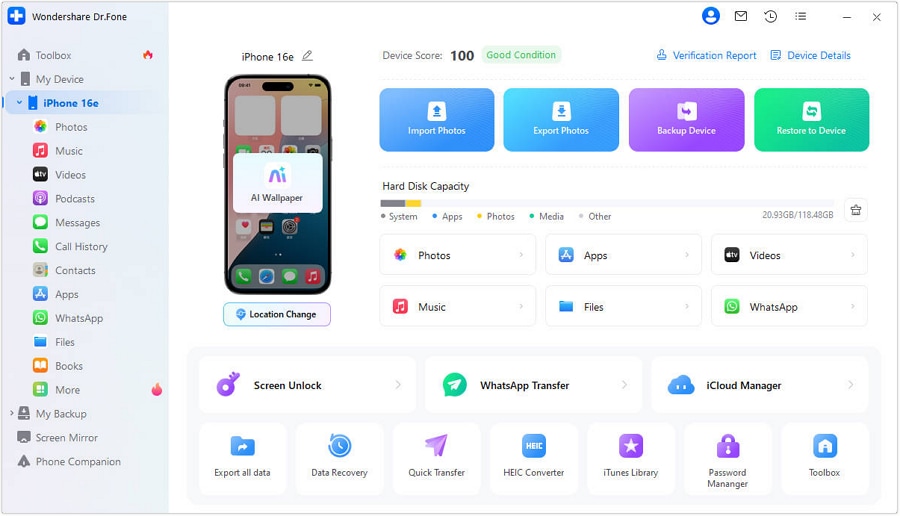
Step 2. A new window will appear. Click Select Files to import your files. Alternatively, drag and drop them to the window.

Step 3. Wait for your file to upload. Then, select the target app to transfer the files. You can select Music, Photos, Dr.Fone Link, and more.
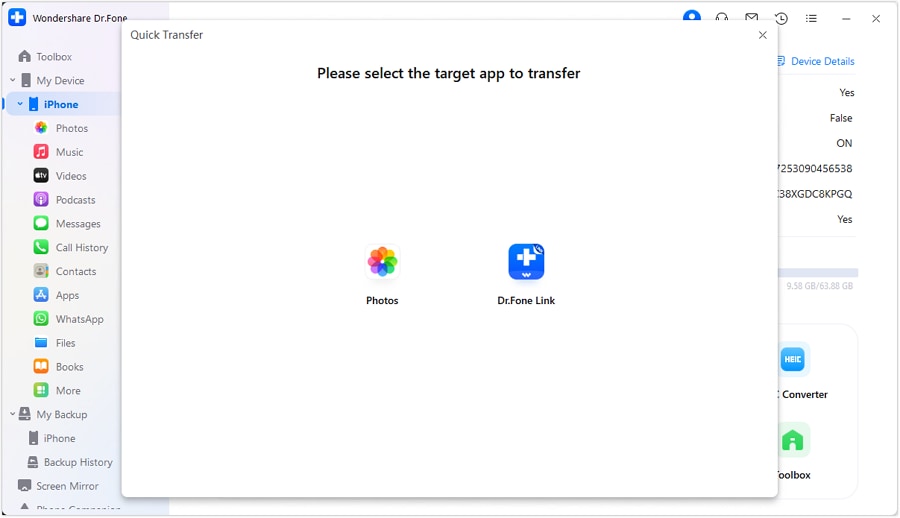
Step 4. Dr.Fone will start sending your files to your iOS device. You can track the transfer using the progress bar on your screen.
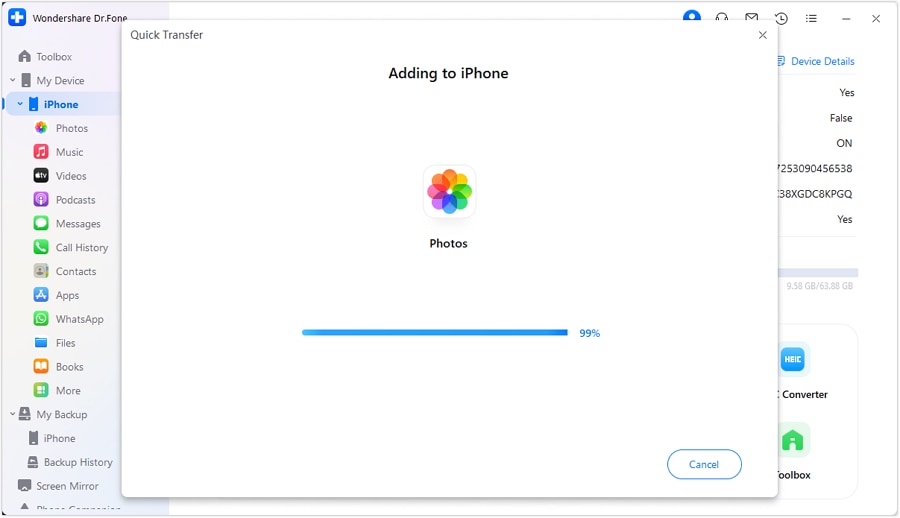
Step 5. Wait for the data transfer to complete. You will see a Done message indicating the transfer’s success. Click the “i” icon to find the location of your files.

Part 4. How to Download Music on iPhone Without iTunes via Streaming Apps
Are you seeking a way to download music to your device without using iTunes? You can use streaming platforms like Apple Music. YouTube Music also offers an easy workaround.
Let’s find out how to transfer music to an iPhone without iTunes using these.
Way 1. Download via YouTube Music
Are you wondering how to download music on your iPhone without iTunes for free? YouTube Music can be the solution you need. It allows you to upload a hundred thousand songs for free. You can upload them from your PC and download them on the iPhone.
How’s how:
Step 1. Go to the YouTube Music website on your computer. Sign in to your YouTube account.
Step 2. Click the profile icon at the top right. Then, choose “Upload music.” Select the music tracks you want to export.

Step 3. Download YouTube Music on your iPhone. Log in to the same YouTube account you used on the computer.
Step 4. Tap “Library” and go to “Songs” > “Uploads.” Here, you will find the uploaded music files.
Step 5. Tap the songs to listen to them on YouTube Music. Otherwise, tap the three dots after the song and click “Download.”

Way 2. Download from Apple Music
Are you thinking about how to put music to your iPhone without iTunes directly? You can subscribe to Apple Music to stream and download your favorite songs.
The app offers millions of tracks from various artists. You can stream them live in Spatial Audio with Dolby Atmos. Alternatively, download them for offline listening.
Here’s what to do.
Step 1. Open the Settings app. Scroll down and tap “Music.” Then, toggle on “Sync Library.”

Step 2. Open the “Music” app. Browse for the songs you want to put on your iPhone.
Step 3. Tap the three horizontal dots in the upper right. Then select “Add to Library.”
Step 4. Tap the “Library” option at the bottom. Select the song, album, or playlist you added.
Step 5. Tap the three dots next to the song. Select “Download” from the pop-up.

Step 6. Wait for the download to complete. Look for the grey circle with a down arrow to confirm the download.
Conclusion
That wraps up how to transfer music to an iPhone without iTunes! You can use storage services, email, or streaming apps to achieve your data transfer. While manual solutions give you more control, they can be lengthy and unreliable. Errors in the transfer can cause you to lose your music data.
Wondershare Dr.Fone offers a seamless way to transfer data to your iPhone. It allows you to send large music libraries without complex operations. Rest assured, your data stays safe during the process.
FAQs
Dr.Fone Basic:
Better Control for Your Phone
Manage, transfer, back up, restore, and mirror your device
iPhone Music
- Download Music to iOS
- 1. Download Music to iPhone
- 2. Download Songs on iPhone/iPad/iPod
- 3. Download Free Music on iPhone
- 4. Download on iPhone without iTunes
- Make iPhone Ringtones
- 1. Set Voice Memo a Ringtone on iPhone
- 2. Ringtone Apps to Download Ringtones
- 3. Add Custom Ringtones to iPhone
- 4. iPhone Ringtone Apps
- 5. Ringtone Maker Apps for iPhone
- 6. Change iPhone Alarm Volume
- 7. Set A Ringtone on iPhone
- 8. Set MP3 As Ringtone iPhone
- 9. Set Ringtone iPhone
- 10. Make Custom Text Tones for iPhone
- 11. Websites for Free iPhone Ringtones
- 12. Move Ringtone from iPhone to Android
- 13. Popular iPhone Ringtone Remix
- Transfer Audio Media to iPhone
- 1. Send Ringtone from iPhone to iPhone
- 2. Transfer MP3 to iPhone
- 3. Transfer Audiobook from PC to iPhone
- 4. Transfer Songs from CD to iPhone
- 5. Put Ringtones on iPhone
- Transfer Music from iPhone
- 1. Transfer Music from iPhone to computer
- 2. Transfer Music from iPhone to iCloud
- 3. Transfer Music from iPhone to Android
- 4. Transfer Music from iPhone to iPod
- 5. Put Music on iPhone from Computer
- 6. Add Music to iPhone from Computer
- 7. Sync Apple Music Library
- Transfer Music from iTunes
- 1. Transfer Music from iTunes to iPhone
- 2. Transfer Music from Mac to iPhone
- 3. Transfer Music from Laptop to iPhone
- Transfer Music to iPhone
- 1. Transfer Music from Computer to iPhone
- 2. Transfer Music from Mac to iPhone
- 3. Transfer Music from Mac to iPhone
- 4. Music from PC to iPhone
- 5. Music from PC to iPhone without iTunes
- 6. Transfer Music from Android to iPhone
- 7. Transfer Music from iPad to iPhone
- 8. Transfer Music from iPod/iPhone
- 9. Transfer Music from iPhone to iPhone
- 10. Transfer Music from External Hard Drive
- 11. Transfer to iPhone without iTunes
- 12. Transfer Music to Jailbroken iPhone
- 13. Transfer Music to iPhone
- Transfer Music to iTunes/PC
- 1. Transfer Music from iPhone to iTunes
- 2. Transfer Music from iPhone to PC
- 3. Transfer Music from iPhone to Mac
- 4. Transfer Music between PC and iPhone
- 5. Transfer Music from to PC without iTunes
- iPhone Music Problems
- 1. Song Missing After iOS Update
- 2. Music Won't Play on iPhone
- 3. iPhone Plays Music by Itself
- 4. Apple Music Song Is Not Available
- 5.Fix Apple Music Library Not Syncing
- iPhone Music Tips
- ● Manage/transfer/recover data
- ● Unlock screen/activate/FRP lock
- ● Fix most iOS and Android issues
- Transfer Now Transfer Now Transfer Now


















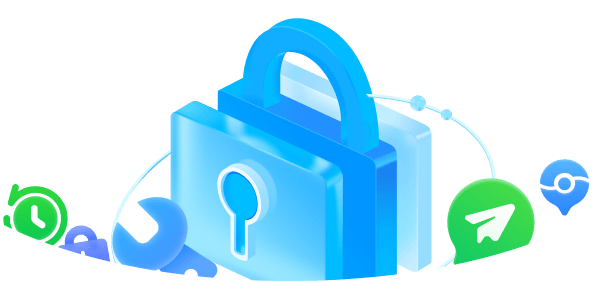
James Davis
staff Editor